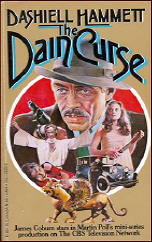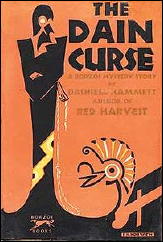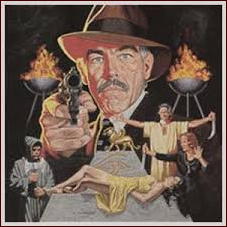Thu 22 Aug 2013
A TV Mini-Series Review by Michael Shonk: THE DAIN CURSE (May 1978).
Posted by Steve under Pulp Fiction , Reviews , TV mysteries[25] Comments
THE DAIN CURSE. CBS – Martin Poll Productions. Based upon the novel by Dashiell Hammett; developed for television by Robert W. Lenski. Producer: Martin Poll. Director: E.W. Swackhamer. Cast: James Coburn as Hamilton Nash, Nancy Addison as Gabrielle Leggett, Bernice Straight as Alice, Jean Simmons as Aaronia, Jason Miller as Owen, Hector Elizondo as Sheriff Feeney and Brent Spiner as Tom Fink.

PART ONE – MAY 22, 1978 – MONDAY AT 9-11 PM (Eastern)
PART TWO – MAY 23, 1978 – TUESDAY AT 9-11 PM
PART THREE – MAY 24, 1978 – WEDNESDAY AT 9-11 PM
THE DAIN CURSE features three stories – a simple diamond robbery that reveals a complex mystery involving drugs, child abuse, blackmail and various murders; a con using a religious cult that ends with death; and a middle aged PI who must overcome his attraction to a young innocent girl and save her from the evil around her.
THE DAIN CURSE originally appeared as four separate Continental Op stories in Black Mask magazine. Hammett would rework the four stories (“Black Lives†November 1928, “The Hollow Temple†December 1928, “Black Honeymoon†January 1929 and “Black Riddle†February 1929) into a three-part novel (Knopf, 1929). While it was a critical and commercial success when first published, time has not been kind to one of Hammett’s weakest work. The book suffers from its clumsy structure, its padded overly complicated story and a weak ending.

The TV adaptation by Robert W. Lenski would win him an Edgar award and an Emmy nomination (losing to HOLOCAUST writer Gerald Green). Surprisingly, there was no writer credit on screen, instead Lenski received a developed for television credit. Perhaps this was because he stayed loyal to the book and its structure. But changes were made, some were wise, others not.
Characters such as Minnie the maid’s boyfriend and many red herrings were wisely dropped. The end of each part was changed. Hammett ended each part with the dramatic closure of that part’s case. Lenski knew each TV episode would need a cliffhanger ending to bring back the viewer for the next night. For example, he followed the book closely, but ended Part One with something that happened in Part Two – The Temple, drugged Gabrielle confessing to murder.
Many of the changes were minor such as changing the Continental Detective Agency to Dickerson National Detective agency and moving the action from the California coast to the East coast and “The City†(New York).
Lenski should have used even more of Hammett’s original dialogue than he did. His original dialogue tended toward pulp clichés, such as a place smelling of death or things being too quiet.
The most notable change was replacing Hammett’s Continental Op with PI Hamilton Nash played by James Coburn. The well-dressed Ham owed more to the crime-fighting image of Dashiell Hammett than to the Continental Op. While Coburn would have been a terrible choice to play the Op, he was perfect as the thin, handsome, more energetic PI Hamilton Nash.
Hammett’s Continental Op appeared in 36 short stories (four would make up Hammett’s first novel RED HARVEST, and four became THE DAIN CURSE). The Op was the visual opposite of TV PI Hamilton Nash. He was a short, overweight (180 lbs), ugly, middle-aged man. He had no life outside of his work. Hammett never even gave him a name. It was this image that made the relationship between the Op and the young victim Gabrielle so important to the tone of the book. It added to the creepiness of the all ready odd mystery as the Op got deeper into Gabrielle’s life, resisting and denying his growing attraction to her and her growing dependence on him, a favorite older Uncle who was fighting inside his desires for the young innocent girl.
Hamilton Nash had a past he hid from others. To keep his noisy boss satisfied (you would think the boss of a detective agency would know the past of his employees) Ham claimed he had an ex-wife who had run off with the milkman because he was never at home. Coburn with his leading man looks and thin athletic body did not seem as wrong for young but adult looking Nancy Addison as the Continental Op did for the virginal Gabrielle.
But Coburn’s Hamilton Nash did share the cynical soul of the Op, as well as the Op’s obsessive personality, his deductive talents, and his fatalistic acceptance of injustice. According to Nash, criminals had invented justice. Nash had no problem leaving a case the client thought solved, even when he knew better.

Nancy Addison had the difficult role of the freaky Gabrielle. Her scenes with Coburn brought to life Hammett’s Gabrielle’s feelings for the older PI who was always there to save her. To her Nash was a protector not a potential lover.
The rest of the cast, especially Jason Miller and Jean Simmons, captured Hammett’s characters well in their performances. Early in the book, Mrs. Alice Leggett was described as being serene and the only sane soul in the Leggett’s household. This played a role in the story. Bernice Straight performance failed to capture that aspect of Alice, but her performance did get her an Emmy nomination for single performance by a supporting actress in a comedy or drama series (she lost to HOLOCAUST Blanche Baker).
E.W. Swackhamer’s direction was worthy of the Emmy nomination he received (he lost to HOLOCAUST director Marvin J. Chomsky). He kept the characters moving to give a sense of energy and tension to the slow paced twisty story. In Part One’s denouement scene, several people filled the lab of the dead man. Nash refused to believe the letter left by the man was a suicide note. Swackhamer had Nash restlessly moving around the room while the rest stay still. As Nash declares the man was murdered, he moves out of the shot (but not out of the room) leaving the camera focused on the reactions of the rest of the people there.

Production values for THE DAIN CURSE were average at best, but never let down the story. Music by Charles Gross reminded us the time was 1928, and added a nice noir sound when needed.
Following the success of the mini-series ROOTS, CBS had high expectations for THE DAIN CURSE. The ratings for the first night were a moderate success with a 37 share. But the ratings for the second and third night fell with each episode receiving a 30 share, OK but not the blockbuster numbers hoped for by CBS.
THE DAIN CURSE aired during the May sweeps, an important ratings period for the networks and its local stations. ABC, CBS, and NBC were going all out to attract viewers. Viewers not hooked by Part One of THE DAIN CURSE had other options, including one in syndication.
THE BASTARD (aka THE KENT FAMILY CHRONICLES) from Operation Prime Time (OPT) scrambled the regularly scheduled programs for that week. OPT was a group of independent TV stations who had united to finance programs from major studios. Produced by MCA/Universal, THE BASTARD was a four-hour mini-series scheduled to air over two nights. It proved a major challenge to THE DAIN CURSE when the two series aired against each other in many markets. Another problem for CBS and the other networks was THE BASTARD aired not only on 25 independent TV stations but also on network stations preempting network programs. THE BASTARD appeared on 14 ABC, 27 CBS and 25 NBC stations.
I would like to read THE DAIN CURSE in its original Black Mask format, but the original four stories reportedly have never been republished. The book was a disappointment. It was padded and told three weak stories instead of one strong one. The TV mini-series was never able to overcome the problems of the novel and added some of its own, most notably the effect casting played on the romantic spine of the story.
Sources:
Broadcasting Magazine – May 15, 1978, May 29, 1978, and June 5, 1978.
The Dashiell Hammett website by Mike Humbert:
http://www.mikehumbert.com/Dashiell_Hammett_05_The_Dain_Curse.html
Editorial Comment: The first two videos consist only of clips from the show. I do not know if the bottom one is the complete mini-series or not, as I have not watched it to the end. I am suspicious about it, as it is only three hours long.
Also Note: Curt Evans reviewed the novel version of The Dain Curse earlier on this blog. Follow this link.
August 23rd, 2013 at 8:10 am
I remember reviewing this one for my zine in DAPA-EM back in 1978. I don’t remember much about the mini-series, though, other than Coburn’s peformance.
August 23rd, 2013 at 10:58 am
The three hour clip above is an edited version (I think it is from the VHS). The mini-series was six hours long with three episodes of two hours each.
The Continental Op is my favorite character in all of fiction. He is a good example why I prefer Hammett over Chandler. Both The Op and Philip Marlowe were obsessive PIs. While Marlowe was a romantic, a knight walking down the mean streets in search of justice, The Op was too cynical to believe in justice.
Hammett had not yet adjusted from the short story to the novel format. The Op’s realism and fatalism allowed Hammett to turn three cases into a book, with the Op drawn back in after the case was closed.
You would think the three cases structure would have been perfect for a mini-series. But the cliffhanger endings for the TV version forced the cases together and wasted the advantages of the episodic nature of the book.
August 23rd, 2013 at 11:45 am
Michael
The edited version of the mini-series came up in the comments following Curt Evans’ review of the book, but thanks for reminding me of it again.
Not that it’s relevant to anyone but myself, but here’s a coincidence for you. Between the time you sent me this review and the time I got it posted, I was helping my wife clean out her bedroom dresser, and we came across a clipping from TV GUIDE containing a short obituary for Nancy Addison. She died in 2002.
My wife was a big fan of the soap opera RYAN’S HOPE, and Addison had a long-running role in that show. Judy had saved the clipping all these years, but probably hadn’t seen it for a long time until this review came along.
August 23rd, 2013 at 11:48 am
I remember seeing this on broadcast television and loving, not liking, the production. When available on DVD I immediately acquired a copy and the charm was missing. Coburn and Malchy McCourt still great. The rest left me on empty.
August 23rd, 2013 at 12:00 pm
I really enjoyed this when it was broadcast, but my memory (not senility — NOT) played me false by assuming the lead was played by Jason Robards.
August 23rd, 2013 at 12:28 pm
#3. Steve, I was surprised to see I had commented on the Curt Evans review. I was going to comment on Nancy Addison’s death, but then realized how many of those mentioned are gone.
#4. Barry, I was a TV critic at the time and hated the show. This time I read the book first and saw what I disliked was due to the book. Jason Miller work I hated the first time, I now realize was dead on Hammett’s character. I am a big fan of Coburn, but there were moments his grin annoyed me, then there were moments his unique use of his limbs fit perfectly. McCourt was perfect as the annoying Mickey. I thought Tom Bower as Sgt O’Gar, Clarence Felder as Dick Foley and Roland Winters (Charlie Chan) as Hubert Collinson were all good as well.
August 24th, 2013 at 2:40 pm
At the time Dain Curse was prepared for broadcasting a wave of renewed Hammett interest permeated the culture. Three principal sources: Jason Robards performance in Julia; Joe Gores book, Hammett, and a reissue in paperback of the complete works. A real treasury of information and entertainment.
August 24th, 2013 at 10:45 pm
7. Barry, you’re right. The 70s paperbacks reintroduced younger readers to the pulp writers. There was a “Thin Man” paperback that had Hammett pose for the cover looking somewhat like PI Hamilton Nash.
August 25th, 2013 at 5:54 pm
I remember seeing this when it aired, but that’s all I remember about it. Much was made in the press at the time about the name “Hamilton Nash” and making the detective resemble Hammett. A friend of mine who is a big Hammett fan absolutely hated the mini-series. I think he felt it didn’t do justice to the original.
Walker, you must have read the original novelettes, what did you think?
Someone at church with whom I discuss detective fiction from time to time has been reading Hammett lately. She had started with The Thin Man, but had never seen the movies and did not know there were movies. (I’ve encouraged her to look them up, probably at the local public library.) She told me this morning that her husband, a big fan of The Maltese Falcon film, had just discovered the book and was equally taken by it.
And so it goes.
August 25th, 2013 at 6:00 pm
I guess the lesson of this story is you had to be crazy to go up against “Holocaust” at the Emmys.
Hammett’s Continental Op delivers what in my mind is the best description I have ever read of a hardboiled detective, I believe in “Red Harvest”: “i’ve got hard skin all over what’s left of my soul.”
August 25th, 2013 at 6:28 pm
9. Randy, I recently read Hammett’s “Thin Man” novel and was surprised I preferred the film. Screenwriters (and married couple) Albert Hackett and Frances Goodrich with Myrna Loy brought Nora Charles to life. In the book I found Nora too content to serve coffee and leave the guys alone (though she had her moments).
August 25th, 2013 at 6:36 pm
10. David, even then it was not unusual for one show to sweep the Emmy awards.
I liked “Red Harvest” but the Continental Op is at his best in short stories. “The Big Knockover,” a collection of short stories, is one of my favorite books.
August 25th, 2013 at 7:13 pm
Randy Cox in comment #9 wonders if I read the original novelets. Yes, I read the 4 novelets that make up THE DAIN CURSE and they are better as stand alone stories that have a connection. Hammett or the publisher cobbled the stories together and made the novel but they read better as individual novelets in a series.
I’ve heard that the present owner of BLACK MASK intends to publish the Hammett stories in two or more collections and then we will be able to compare the stories to the novel, etc.
August 25th, 2013 at 8:50 pm
#13. Cool. Walker, I suspect its been too long for you remember or even find your copies, but I am curious how Hammett merged four stories into three parts.
In the book, Part One – The Dains ends with the Op called back from another case (the client had closed case of robbery).
Part Two – The Temple ends with Op telling Owen that he had got fired after Collinson and Gabrielle ran off to be married (the TV version had The Op attend her wedding).
Part Three – Quesada began with Collinson’s telegram to the Op for help.
The three parts seemed natural for three novellas and I have wonder what got chopped to make four into three.
Is there anybody out there who could answer that?
August 26th, 2013 at 9:54 am
Possibly irrelevant and certainly trivial fact, regarding the name bestowed here on the Contineal Op, “Hamilton Nash.”
In the latter 1970s, CBS filled an empty hour with an unsold pilot that starred Michael Murphy as a police detective, and Joanna Pettet as an insurance investigator. Pettet’s character was named Allison Nash–well, after all these years, I cannot be certain about the “Allison,” but I am definite about the “Nash.” At one point she tries to impress someone by claiming to be a niece of a billionaire named…Hamilton Nash. Possibly this was only a coincidence, but I have always assumed that someone in this production had also been involved in “The Dain Curse,” and had thrown this in as an in-joke.
The IMDB does not list anything matching this under either actor’s credits. However, using Google, I find someone offering a publicity photo of Murphy and Pettet, from something called “Winner Take All.” That has to be it–except that the seller gives “Winner” a broadcast date of April 1, 1977, while you have “The Dain Curse” debuting in May 1978. I watched “The Dain Curse” on its original broadcast, and I watched “Winner Take All” on what must have been its only broadcast, and I definitely remember being struck by the character name from the former being used in the latter. So, a (very) minor mystery there. (Obvious solutions: The photo seller made a typo, and meant 1979. Or, “Winner” was originally scheduled for broadcast in 1977, but was knocked off the schedule for some reason or other, and was not shown until more than a year had passed–but that makes the “Hamilton Nash” more likely to be a coincidence. Well, enough of this.)
August 26th, 2013 at 11:12 am
I haven’t had time to investigate more thoroughly, but IMDb does have a bare bones entry for WINNER TAKE ALL with a date of 1977.
http://www.imdb.com/title/tt0076924/reference
August 26th, 2013 at 11:14 am
Here’s more
http://news.google.com/newspapers?nid=1917&dat=19770326&id=PjkwAAAAIBAJ&sjid=jeAFAAAAIBAJ&pg=3479,6719351
from a newspaper dated March 26, 1977, with quite a few details of the film, including Pettet’s name in the movie, Allison Nash.
And with that, I’m out for the day.
August 26th, 2013 at 1:44 pm
I’m certain that one of the many biographies or critical studies of Dashiell Hammett (and I think there’s a five-foot shelf of them) contains the relevant information about the original Black Mask novelettes and what was done to them in the novel.
11. michael: I’ve heard this about the “Thin Man” films being better than the novel from several sources. It’s been far too long since I’ve read the book or seen any of the films to pass any personal judgment.
August 26th, 2013 at 3:13 pm
15. Bosworth Fields, every studio has or uses a research department. One of the primary jobs of the department is to clear names so the filmmakers won’t be sued by a real Hamilton Nash millionaire or Hamilton Nash PI. Some writers avoid this by using cities or rivers or objects as names. It is not unusual for a name to be used over and over or by others.
The IMDB tries but is incomplete. Many of my reviews here has cast listings not included on IMDB.
My guess is you watched WINNER TAKE ALL as a syndicated rerun. In the 70s, the networks made pilots as TV Movies because there was a market among local stations trying to fill its off-prime time schedules.
I know what it is like to have a TV show stuck in your head, like a song that drives you crazy. Hope we’ve help solve the mystery.
August 26th, 2013 at 3:25 pm
18. Randy, Hammett was involved with the film THIN MAN as well so its not a surprise the film kept the positive and improved the character of Nora.
The book “Return of the Thin Man” is worth reading just to see how much of the sequels AFTER THE THIN MAN and ANOTHER THIN MAN came from Hammett.
It was fun to learn the Charles’ baby was the writers attempt to kill the film series. It was due to a determined producer and a movie audience in love with Nick and Nora Charles that kept the movies coming despite its drop in quality.
August 28th, 2013 at 2:15 pm
Up in the comments section of Dan Stumpf’s excellent review of LA DONNA DEL LAGO, Barry brought up the common belief that The Fat Man is the closest film got to the Continental Op.
The belief the two are linked began when the radio series proclaimed THE FAT MAN was created by Dashiell Hammett. Hammett’s actual involvement in THE FAT MAN remains in doubt, from just selling his name and cashing the check to Hammett writing some of the episodes. But whatever, there remains too many differences for me to call the two the same character.
The Continental Op weighed 180 lbs, despite the Op’s characteristic of self-deprecating he was not fat but overweight (I am about the same height as the Op and weighed from 180 to 300 pounds). Depending on your body shape 180 is chubby at most. The Continental Op was a cynic who worked for an agency as just another faceless agent. He worked to solve the client’s problem, not some romantic view of justice. He had no family, no name. Nothing beyond work.
The Fat Man weighed around 240 and was fat. He worked to find the romantic view justice. He had his own agency. He had a mother and a girlfriend. He had the Op’s characteristic of self-deprecating, but not his cynicism. The Op obsessed over work, The Fat Man obsessed over food. He was closer to a Nero Wolfe who wasn’t lazy and didn’t have an Archie than he was to the Continental Op.
August 28th, 2013 at 4:33 pm
That is quite strong Michael, and appreciated. I don’t think the exact poundage matters except as the radio opening. Each generation we see men get bigger, taller and heavier. In any case, the Coburn character seems to be clearly modeled on Hammett. Yes…?
August 28th, 2013 at 4:42 pm
#22. Yes, while no one admitted it, Hamilton Nash character was modeled on Hammett image as a PI. And Coburn was a great choice to play him.
Have you ever seen the movie, THE FAT MAN based on the radio series?
August 28th, 2013 at 5:38 pm
Michael —
I have and was disappointed in J. Scott Smart. Loved him when I could not see him. The film otherwise, I found, slow to the tedious point. And cheaply made. Liked the other leads. Hudson was fine and Emmett Kelly — though that played like a casting stunt. Raymond Burr for Brad Runyon…?
August 28th, 2013 at 6:08 pm
Barry, I agree the film was a disappointment even for someone like me not expecting much. The radio show, much like THE THIN MAN radio and TV series, had some good stuff but lack consistency from week to week. But then they all can’t be radio’s ADVENTURES OF SAM SPADE, so maybe I judge too harshly.